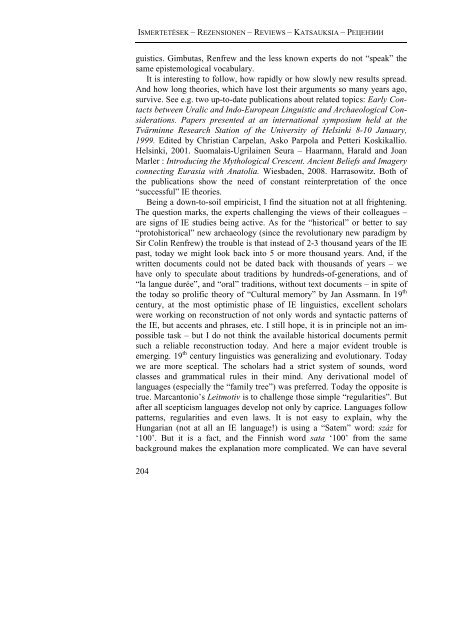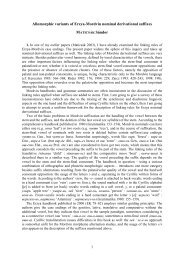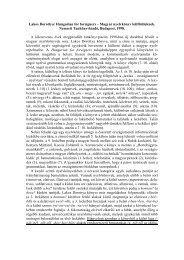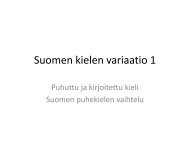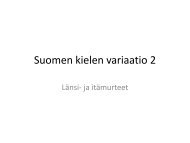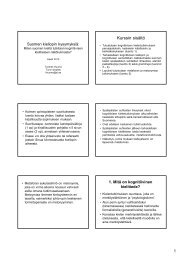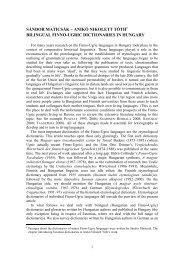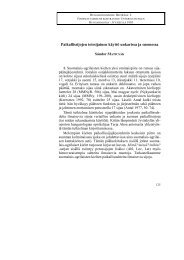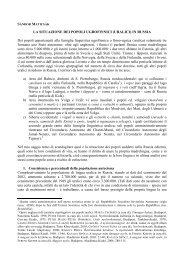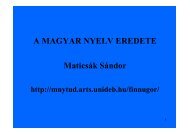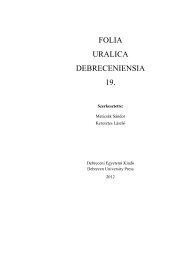- Page 1 and 2:
FoliaUralicaDebreceniensia17.Debrec
- Page 3 and 4:
A DEBRECENI EGYETEMFINNUGOR NYELVTU
- Page 5 and 6:
ЛЮДМИЛА ГРОМОВАИз
- Page 7 and 8:
ЛЮДМИЛА ГРОМОВАтак
- Page 9 and 10:
ЛЮДМИЛА ГРОМОВАкач
- Page 11 and 12:
ЛЮДМИЛА ГРОМОВАв л
- Page 13 and 14:
ЛЮДМИЛА ГРОМОВАГри
- Page 15 and 16:
JANURIK TAMÁSJóllehet az uráli n
- Page 17 and 18:
JANURIK TAMÁS3.3. Denominális né
- Page 19 and 20:
JANURIK TAMÁSIII. Közszamojéd k
- Page 21 and 22:
JANURIK TAMÁSPS *-ŋ-PS *-s-SW 60
- Page 23 and 24:
JANURIK TAMÁSHatározószóból k
- Page 25 and 26:
JANURIK TAMÁSDie rekonstruierbaren
- Page 27 and 28:
KELEMEN IVETT2. Páros testrésznev
- Page 29 and 30:
KELEMEN IVETTkönnyen kifejlődhete
- Page 31 and 32:
KELEMEN IVETTláb (2): Lababol saru
- Page 33 and 34:
KELEMEN IVETTKertész Manó 1913: A
- Page 35 and 36:
MATICSÁK SÁNDORe) ritmus: рит
- Page 37 and 38:
MATICSÁK SÁNDORAz agglutinációv
- Page 39 and 40:
MATICSÁK SÁNDOR’szövetség; te
- Page 41 and 42:
MATICSÁK SÁNDOR40наём мы,
- Page 43 and 44:
MATICSÁK SÁNDORa) Az eredeti öss
- Page 45 and 46:
MATICSÁK SÁNDORMészáros Edit 19
- Page 47 and 48:
TERHI PELTOLAImitating is the most
- Page 49 and 50:
TERHI PELTOLAwere recorded with a M
- Page 51 and 52:
TERHI PELTOLAareas. This might well
- Page 53 and 54:
TERHI PELTOLAAccording to the resul
- Page 55 and 56:
DEBRECENI EGYETEMFINNUGOR NYELVTUDO
- Page 57 and 58:
EGYEZTETÉSI TÍPUSOK: A SZÁMBELI
- Page 59 and 60:
EGYEZTETÉSI TÍPUSOK: A SZÁMBELI
- Page 61 and 62:
EGYEZTETÉSI TÍPUSOK: A SZÁMBELI
- Page 63 and 64:
EGYEZTETÉSI TÍPUSOK: A SZÁMBELI
- Page 65 and 66:
EGYEZTETÉSI TÍPUSOK: A SZÁMBELI
- Page 67 and 68:
EGYEZTETÉSI TÍPUSOK: A SZÁMBELI
- Page 69 and 70:
DEBRECENI EGYETEMFINNUGOR NYELVTUDO
- Page 71 and 72:
A KOMI-PERMJÁK NYELV HELYE AZ OKTA
- Page 73 and 74:
A KOMI-PERMJÁK NYELV HELYE AZ OKTA
- Page 75 and 76:
A KOMI-PERMJÁK NYELV HELYE AZ OKTA
- Page 77 and 78:
A KOMI-PERMJÁK NYELV HELYE AZ OKTA
- Page 79 and 80:
A KOMI-PERMJÁK NYELV HELYE AZ OKTA
- Page 81 and 82:
A KOMI-PERMJÁK NYELV HELYE AZ OKTA
- Page 83 and 84:
A KOMI-PERMJÁK NYELV HELYE AZ OKTA
- Page 85 and 86:
A KOMI-PERMJÁK NYELV HELYE AZ OKTA
- Page 87 and 88:
A KOMI-PERMJÁK NYELV HELYE AZ OKTA
- Page 89 and 90:
A KOMI-PERMJÁK NYELV HELYE AZ OKTA
- Page 91 and 92:
A KOMI-PERMJÁK NYELV HELYE AZ OKTA
- Page 93 and 94:
A KOMI-PERMJÁK NYELV HELYE AZ OKTA
- Page 95 and 96:
DEBRECENI EGYETEMFINNUGOR NYELVTUDO
- Page 97 and 98:
POSSIBILITIES OF ONOMATOSYSTEMATICA
- Page 99 and 100:
POSSIBILITIES OF ONOMATOSYSTEMATICA
- Page 101 and 102:
POSSIBILITIES OF ONOMATOSYSTEMATICA
- Page 103 and 104:
POSSIBILITIES OF ONOMATOSYSTEMATICA
- Page 105 and 106:
POSSIBILITIES OF ONOMATOSYSTEMATICA
- Page 107 and 108:
POSSIBILITIES OF ONOMATOSYSTEMATICA
- Page 109 and 110:
POSSIBILITIES OF ONOMATOSYSTEMATICA
- Page 111 and 112:
DEBRECENI EGYETEMFINNUGOR NYELVTUDO
- Page 113 and 114:
VALIKOITUJA PALOJA KOGNITIIVISESTA
- Page 115 and 116:
VALIKOITUJA PALOJA KOGNITIIVISESTA
- Page 117 and 118:
VALIKOITUJA PALOJA KOGNITIIVISESTA
- Page 119 and 120:
VALIKOITUJA PALOJA KOGNITIIVISESTA
- Page 121 and 122:
VALIKOITUJA PALOJA KOGNITIIVISESTA
- Page 123 and 124:
VALIKOITUJA PALOJA KOGNITIIVISESTA
- Page 125 and 126:
VALIKOITUJA PALOJA KOGNITIIVISESTA
- Page 127 and 128:
VALIKOITUJA PALOJA KOGNITIIVISESTA
- Page 129 and 130:
DEBRECENI EGYETEMFINNUGOR NYELVTUDO
- Page 131 and 132:
A LETTER FROM HEJKKI HANNON BÅJGAS
- Page 133 and 134:
A LETTER FROM HEJKKI HANNON BÅJGAS
- Page 135 and 136:
A LETTER FROM HEJKKI HANNON BÅJGAa
- Page 137 and 138:
A LETTER FROM HEJKKI HANNON BÅJGAi
- Page 139 and 140:
A LETTER FROM HEJKKI HANNON BÅJGAV
- Page 141 and 142:
A LETTER FROM HEJKKI HANNON BÅJGAL
- Page 143 and 144:
DEBRECENI EGYETEMFINNUGOR NYELVTUDO
- Page 145 and 146:
A NGANASZAN DEIKTIKUS NAPNEVEK REND
- Page 147 and 148:
A NGANASZAN DEIKTIKUS NAPNEVEK REND
- Page 149 and 150:
A NGANASZAN DEIKTIKUS NAPNEVEK REND
- Page 151 and 152: A NGANASZAN DEIKTIKUS NAPNEVEK REND
- Page 153 and 154: A NGANASZAN DEIKTIKUS NAPNEVEK REND
- Page 155 and 156: A NGANASZAN DEIKTIKUS NAPNEVEK REND
- Page 157 and 158: A NGANASZAN DEIKTIKUS NAPNEVEK REND
- Page 159 and 160: JUDIT TAKÁCSovat esimerkiksi tasku
- Page 161 and 162: JUDIT TAKÁCSSaatujen yleissanojen
- Page 163 and 164: JUDIT TAKÁCSAineistoni perusteella
- Page 165 and 166: DEBRECENI EGYETEMFINNUGOR NYELVTUDO
- Page 167 and 168: FÖLDRAJZI VISZONYOK ÉS ÉGTÁJMEG
- Page 169 and 170: FÖLDRAJZI VISZONYOK ÉS ÉGTÁJMEG
- Page 171 and 172: FÖLDRAJZI VISZONYOK ÉS ÉGTÁJMEG
- Page 173 and 174: FÖLDRAJZI VISZONYOK ÉS ÉGTÁJMEG
- Page 175 and 176: FÖLDRAJZI VISZONYOK ÉS ÉGTÁJMEG
- Page 177 and 178: FÖLDRAJZI VISZONYOK ÉS ÉGTÁJMEG
- Page 179 and 180: DEBRECENI EGYETEMFINNUGOR NYELVTUDO
- Page 181 and 182: A MORDVINISZTIKA MÁSFÉLSZÁZ ÉVE
- Page 183 and 184: A MORDVINISZTIKA MÁSFÉLSZÁZ ÉVE
- Page 185 and 186: A MORDVINISZTIKA MÁSFÉLSZÁZ ÉVE
- Page 187 and 188: A MORDVINISZTIKA MÁSFÉLSZÁZ ÉVE
- Page 189 and 190: A MORDVINISZTIKA MÁSFÉLSZÁZ ÉVE
- Page 191 and 192: A MORDVINISZTIKA MÁSFÉLSZÁZ ÉVE
- Page 193 and 194: A MORDVINISZTIKA MÁSFÉLSZÁZ ÉVE
- Page 195 and 196: A MORDVINISZTIKA MÁSFÉLSZÁZ ÉVE
- Page 197 and 198: A MORDVINISZTIKA MÁSFÉLSZÁZ ÉVE
- Page 199 and 200: DEBRECENI EGYETEMFINNUGOR NYELVTUDO
- Page 201: ISMERTETÉSEK - REZENSIONEN - REVIE
- Page 205 and 206: ISMERTETÉSEK - REZENSIONEN - REVIE
- Page 207 and 208: ISMERTETÉSEK - REZENSIONEN - REVIE
- Page 209 and 210: ISMERTETÉSEK - REZENSIONEN - REVIE
- Page 211 and 212: ISMERTETÉSEK - REZENSIONEN - REVIE
- Page 213 and 214: ISMERTETÉSEK - REZENSIONEN - REVIE
- Page 215 and 216: ISMERTETÉSEK - REZENSIONEN - REVIE
- Page 217 and 218: ISMERTETÉSEK - REZENSIONEN - REVIE
- Page 219 and 220: ISMERTETÉSEK - REZENSIONEN - REVIE
- Page 221 and 222: ISMERTETÉSEK - REZENSIONEN - REVIE
- Page 223 and 224: ISMERTETÉSEK - REZENSIONEN - REVIE
- Page 225 and 226: ISMERTETÉSEK - REZENSIONEN - REVIE
- Page 227 and 228: ISMERTETÉSEK - REZENSIONEN - REVIE
- Page 229 and 230: ISMERTETÉSEK - REZENSIONEN - REVIE
- Page 231 and 232: ISMERTETÉSEK - REZENSIONEN - REVIE
- Page 233 and 234: ISMERTETÉSEK - REZENSIONEN - REVIE
- Page 235 and 236: ISMERTETÉSEK - REZENSIONEN - REVIE
- Page 237 and 238: ISMERTETÉSEK - REZENSIONEN - REVIE
- Page 239 and 240: ISMERTETÉSEK - REZENSIONEN - REVIE
- Page 241 and 242: ISMERTETÉSEK - REZENSIONEN - REVIE
- Page 243 and 244: ISMERTETÉSEK - REZENSIONEN - REVIE
- Page 245 and 246: ISMERTETÉSEK - REZENSIONEN - REVIE
- Page 247 and 248: ISMERTETÉSEK - REZENSIONEN - REVIE
- Page 249 and 250: ISMERTETÉSEK - REZENSIONEN - REVIE
- Page 251 and 252: ISMERTETÉSEK - REZENSIONEN - REVIE
- Page 253 and 254:
ISMERTETÉSEK - REZENSIONEN - REVIE
- Page 255 and 256:
ISMERTETÉSEK - REZENSIONEN - REVIE
- Page 257 and 258:
ISMERTETÉSEK - REZENSIONEN - REVIE
- Page 259 and 260:
DEBRECENI EGYETEMFINNUGOR NYELVTUDO
- Page 261 and 262:
IN MEMORIAMsekről, az analízis é
- Page 263 and 264:
IN MEMORIAMidézte föl kedvenc tan
- Page 265 and 266:
IN MEMORIAMSuhonen gyorsan haladt a
- Page 267 and 268:
IN MEMORIAMakatemian akateemikko (1
- Page 269 and 270:
IN MEMORIAMVuonna 2003 ilmestyi kau
- Page 271 and 272:
For AuthorsFolia Uralica Debrecenie
- Page 273 and 274:
Ismertetések - Rezensionen - Revie


